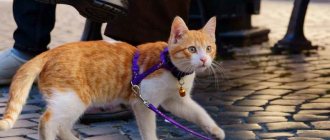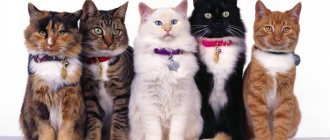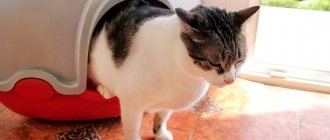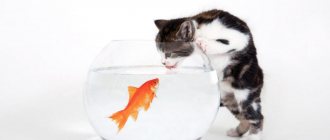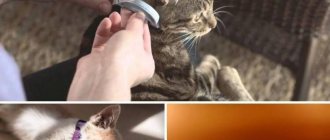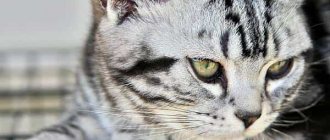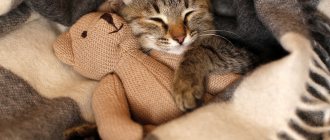How to put a harness on a cat
It should be noted that this accessory should be comfortable for your pet so as not to cause anxiety or unnecessary excitement.
There are several basic steps that will help you correctly and correctly put a harness on your cat:
- It is necessary to let your pet sniff the harness and get used to it in order to avoid unnecessary anxiety.
- Before starting the process, it is important to pick up your pet and, if he appears anxious, pet him and calm him down.
- Do not make sudden, noisy movements, do everything carefully and calmly.
If these points are followed, the procedure will give the desired result and will not take much time. Next, we will look at various methods for collecting harnesses depending on their type.
Types of collars
Choosing a collar for a cat depends on the goals you pursue when choosing. In addition to anti-parasitic (protective), calming (for nervous and aggressive pets) and beautiful decorative collars, there are other types that help not only safely walk your pet, but also track its location:
- self-release collars for walking are the safest type. If the animal gets into a situation in which the collar can play the role of a noose, the structure stretches and frees the pet;
- personal accessories with addresses and names - in case of loss of a pet, a personalized collar with information will help quickly bring the animal back;
- GPS collars - a kind of cat navigator - will not be cheap. However, it will not only be suitable for those who do not want to limit the pet’s freedom of movement, but will also help track its location in case of loss;
- collars with bells - this accessory will help you determine by sound whether your pet is within reach. And will warn other pets about the approach of a small predator.
How to assemble a cat harness
Depending on the configuration, temperament and breed of your pet, there are different variations of harnesses.
The main guiding factor is maximum comfort - it is important that the harness fits your cat and does not rub or squeeze the animal.
There are certain nuances when assembling different types of harnesses.
Eight:
- This accessory consists of parts. One part - a small loop is put on the cat's neck, it should slide over the animal's head, it does not need to be unfastened. The carbine ends up on the animal's back. The front paws are inserted into the second part - a large loop; it should go around the cat's chest. The loops can also be adjusted to make them wider or narrower.
- Next, you should put the smallest of the loops on the animal’s head. The junction of the loop and the connecting strap should be slightly above shoulder level. The middle of the figure eight should lie between the shoulder blades.
- You need to take the ends of the large loop that are located under the animal’s chest and connect them.
- It is important to ensure that none of the loops are twisted and become a source of irritation for your pet.
- It is necessary to check the fit of the belts. There should be 2 fingers between the harness and the animal.
- The leash must be fastened to the ring located in the animal’s back area, after which the harness itself is checked for strength.
A harness is an indispensable accessory for walking.
To ensure that the cat's walks are safe, the owner must purchase a special harness. It consists of two collars, the first of which covers the neck, and the second – the body. The latter is attached to the pet's stomach. The first collar has a ring for a leash, located exactly between the shoulder blades. Thanks to this arrangement, the pressure on the animal's spine is reduced.
The harness and leash are usually included in one set. The length of the leash can be easily adjusted, so that the animal can be released to the required distance. If force majeure occurs, such a design will be very useful.
DIY cat harness
A photo of the V-harness is shown below:
- In order to correctly and competently make a harness for a cat with your own hands, you must initially take measurements of the pet: the circumference of the neck, as well as the chest, the length of the neck from the base of the head to the middle of the chest. The result will be two circles - a large and a small one and a line between them.
- Next we will need A3 paper, a pencil, a ruler and a centimeter. The length of the paper is determined by the size of the animal - it should be the same or slightly longer than the circumference of the cat.
- You also need to add 1 centimeter to the resulting measurements in the drawing to make sure that you have trimmed the fabric enough. This indentation will be the distance between the edge of the fabric and the stitches.
- Then you need to cut out the template and try it on the cat.
- The next step is to prepare the necessary material for making the harness. For this we will need: thick fabric (denim or cotton is recommended, as it is quite dense, soft and durable), lining, thread matching the color of the fabric, scissors, D-ring, protective fabric, sewn-on Velcro.
The protective fabric is used to strengthen the main fabric. It should be the same weight as the other type of fabric or less.
The ring should be wide enough to allow the nylon tape to pass through it freely. The length of the nylon strap itself should correspond to the middle circle of the vest. It is important to note that the thicker the tape, the more difficult it will be to sew.
To make a harness pattern we will need: a sewing machine, scissors, pins, an iron, a tape measure. If you don’t have a sewing machine in your arsenal, you can sew it yourself, but it will take a little more time.
What to choose for a walk
Some believe that with the advent of harnesses, collars have lost their relevance for walking, others believe that a harness does not perform all the functions that a modern leash can perform. Of course, the comparison will be unfair if we do not talk about a specific type of collar or harness.
Harnesses do not have navigator functions, but they are not as convenient for your pet. But if your cat is comfortable with such accessories, why not use both? The choice is yours:
- collar. Easy to use, you can choose a multifunctional one, simple examples are often cheaper than harnesses. But it should be taken into account that navigators are expensive, and the design of the collar itself easily turns it into a noose - all the force put into the leash affects only the neck area;
- harness Provides a comfortable walk, trip, trip to the veterinarian, distributes the load. However, not every pet will agree to wear such a device; it’s easy to tear the fabric harness. If your pet (for example, a kitten) has grown or gained weight, you need to buy a new one.
Pattern of a harness for a cat
- It is necessary to cut out the fabric, lining and face protective fabric, then place the harness diagram on top of the cut out and attach with pins. It is important to remember to indent 1cm from the main measurements.
- Let's start sewing all the parts of the pattern. You should start from the wrong side, folding the edges. This is done to ensure that the seams are inside the vest. Next, you should align the edges relative to each other and stitch around the perimeter, then iron everything.
- On the part of the harness that will be located in the animal's back area, you need to sew a D-shaped ring. It should be threaded through the nylon tape with the rounded part facing out.
- Finally, we sew the Velcro to the harness. They should overlap each other; accordingly, we place part of the Velcro on the wrong side of the pattern, the other on the outside.
After the manipulations have been done, you should try on the resulting vest on the cat and check how it sits on it.
We do it ourselves
You can make a harness for your cat from belts yourself; the quality will not be inferior to store-bought ones, if you choose the right material and stitch the fastenings properly.
Choose dense fabrics: soft denim, nylon. Reliable fastening: buttons, straps with clasp.
To make the common “H” shaped harness model, a large sewing needle is sufficient. Measurements are taken: the chest is grasped behind the front legs, the radius of the neck, and the distance of these measurements from each other.
The width of the straps should not exceed 1.5 cm in finished form. For strength, they are stitched on both sides.
We sew fasteners to the edges for the neck and chest. We connect them with a jumper, onto which we pre-attach the ring for the carabiner of the leash.
For those who love handicrafts and sewing on a sewing machine. Patterns for a harness-vest for a cat are not difficult to find on the Internet. Or come up with an original style.
Photo of harnesses for cats
We're going for a walk
There are two ways to teach dressing, both using the method of positive associations. Screaming and violence will only undermine the pet’s trust.
Treat your purr to his favorite food when you put on his harness or engage him in play. The cat will get used to the smell and learn that it is rewarded when it is dressed. Then the time of contact with the ammunition is extended.
When the cat behaves calmly, without showing anxiety or trying to remove the harness, and stays in it for a long time, you can get ready to go outside.
The first walk always takes place in uncrowded places, with a minimum number of distractions. The cat can be taken outside in a carrier.
Don't pull on the leash to get him out of her. Offer a treat if the animal refuses to eat or play - it means it is stressed. Wait a while, if the condition does not change, then for the first time it is enough.
Cats, cats, kittens - have their own character, fears, and are subject to mood. Be patient and it will be rewarded. There is nothing better than a carefree walk in the company of a purring dog.
Cost of a leash for a cat in a pet store
The range from which you can choose a leash for kittens and cats is quite wide in any pet store. The harnesses come in a variety of colors that can be adjusted. You can also find cat harnesses made from different materials: decorative knitted or reflective. Prices are influenced by the type of harness and brand recognition. The cheapest ones can be found for 150 rubles. Vests are a little more expensive. The average price for all types is 300 rubles*
The variety of harnesses is impressive. Designed for the safety of animals, they make walking with them calm for the owner. You can buy leashes at a pet store, order online, or make a harness for your beloved cat with your own hands. But it is worth remembering that the main factors when choosing this device should be the convenience and comfort of the animal.
*Prices are as of August 2022.
Vest for a cat, instructions
The vest fastens with Velcro and is worn like regular clothing. It warms the animal and does not put pressure on the pet’s body. Even playful cats can easily tolerate the presence of a jacket if it is chosen correctly.
Instructions:
- the vest is applied to the cat’s back, so that the ring for the long leash is at the top;
- paws are pushed into the holes;
- Velcro sticks together on the neck and stomach;
- The leash clings to a loop on the back.
A harness and jacket for a cat is a more convenient solution compared to straps: below are photo instructions.
Advantages and disadvantages of harnesses
Like any design, harnesses also have their pros and cons. What are their advantages?
- The ability to safely walk your furry friend in the fresh air.
- Absolute control over your pet during a walk, be it in the yard or on a trip out of town.
- It is very convenient to visit the veterinarian without keeping the animal in a cage all the time. And also transport your pet on the train, take it to the country, go on a visit and much more.
- The roulette leash allows you to expand the scope of your walk by adjusting the distance.
Now about the cons. They are minor and can easily be avoided if desired.
- Be prepared for the fact that the cat will not immediately accept the harness; the first reaction will be fear.
- At first, the pet will begin to struggle and twitch, so it will need to be trained.
- It happens that cats break out of their harness and run away. This is why it is important to buy a quality product. The same goes for the quality of the leash to the harness.
- If the cat has gained weight, you will have to buy a new product; the old one will weigh on him.
